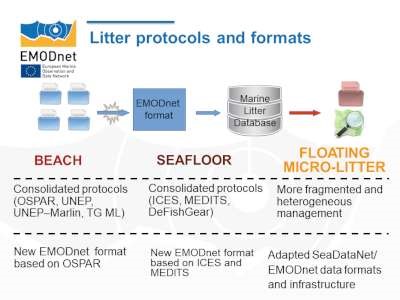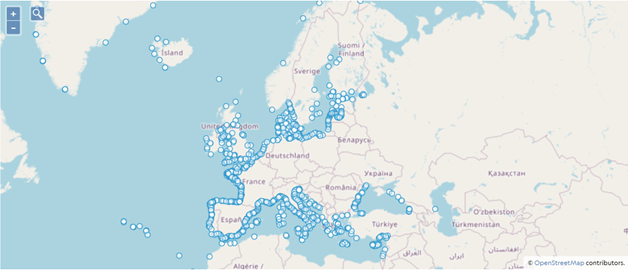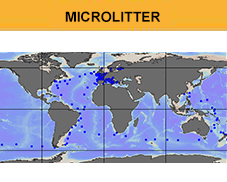Marine Litter
Marine litter is an increasingly serious problem that requires evidence-based action to change human behaviour and mitigate its impact on the environment. For this purpose, EMODnet Chemistry developed and manages the first pan-European Marine Litter Database (MLDB) on the advice of the MSFD’s Marine Litter Technical Group (TG ML) and in close cooperation with relevant stakeholders in the EU, such as the European Commission’s Joint Research Centre, Regional Sea Conventions, EU Member States, and International Council for the Exploration of the Sea.
The database contains data of beach / seafloor macrolitter and floating/sediment microlitter from a variety of sources. These include the Regional Sea Conventions, EU Member States, EMODnet partners, and external research or monitoring projects as well as NGOs, citizens, and private companies. Most datasets come from existing monitoring projects that have published their data in project-specific databases (e.g. OSPAR and ICES DATRAS). As these databases may contain more and differently formatted information than given here, a direct comparison with these sources is not always possible.
The MLDB is a major milestone in the harmonisation of available information at the European level, supporting the establishment of European baselines and threshold values for the MSFD.
Currently, more than 36 400 records and CDI metadata are stored. The number of records per macro-litter category is shown in the table below (updated to 30 June, 2022).
| Macro category | No. of records |
|---|---|
| Beach macrolitter | 13 662 |
| Seafloor macrolitter | 22 415 |
| Floating microlitter | 358 |
Two different approaches are adopted depending on the type of marine litter. For beach and seafloor litter, the existence and adoption of consolidated protocols have led to the implementation of a centralised data flow. For microlitter, on the other hand, the distributed data flow and standards of SeaDataNet were chosen owing to the lack of widely shared protocols, resulting in a rather fragmented and heterogeneous management system.
Data from very different sources have been gathered into the MLDB with common beach and seafloor formats developed in the framework of the project. The new formats, based on existing monitoring protocols and data reporting sheets, allow users to process heterogeneous datasets while keeping the main information and metadata.
Microlitter data are gathered in the system using a specific version of ODV formats where relevant characteristics are codified using common vocabularies .

The MLDB is accessible via the CDI Data Discovery and Access service :
The Service provides relevant metadata, including the identifier, date and location of the survey, data originator, and data holding centre for all datasets. The data are available for download in the formats of EMODnet Chemistry, depending on the specific sharing policy applied by the originator.
How to submit data
Eager to submit your data? Check out the Marine litter data-flow (see the collapsible boxes below): an intuitive and concise step-by-step scheme on how to share marine litter data using fit-for-purpose guidelines, tools, and software. In particular, this one-page guide provides information on formatting, validating, and submitting data on beach litter, seafloor litter, and floating microlitter.
- Format Data
- Use the guidelines and forms for gathering marine litter data;
- Use Marine Litter Manager tool to format beach litter data;
- See Beach litter vocabularies and SeaDataNet Common vocabularies terms to describe beach litter data;
- Visualize the Beaches map to check where the beaches included in the EMODnet database are located;
- Download some Example files
- Validate Data
Use the EMODnet Beach Litter Format Validator to validate data. - Send Data
Send the data to EMODnet Chemistry
- Format Data
- Use the guidelines and forms for gathering marine litter data;
- Use Marine Litter Manager tool to format data;
- See ICES vocabularies and to describes Sea Floor litter data;
- Download some Example files
- Validate Data
Use EMODnet SeaFloor Format Validator to validate data. - Send Data
Send the data to EMODnet Chemistry.
- Format Data
- Use the Proposal for gathering and managing data sets on marine micro-litter ;
- Use to format data (ODV micro-litter format);
- Use to generate metadata file (CDI);
- Download some example files (floating and sediment).
- Validate Data
Use OCTOPUS software to validate data. - Submit metadata
Populate your CDI metadata and Micro Litter data sets into the SeaDataNet CDI Data Discovery and Access service.
Tools & Vocabularies
Together with the partnership's research and monitoring institutes, the national oceanographic data centres collect and format the available information to populate the EU marine litter database. The specific tools developed and used to visualise, format (syntactically and semantically), and validate marine litter data are briefly described below:
Marine Litter Manager
The Marine Litter Manager generates EMODnet beach and seafloor data formats. The software is downloadable on GitHub, where the user manual and dedicated videotutorials are also available.
EMODnet Beach Litter Format Validator
EMODnet Beach Litter Format Validator allows users to check correctness and approve EMODnet beach litter data files.
Once beach litter data are formatted in compliance with the official specifications (dx.doi.org/10.6092/15c0d34c-a01a-4091-91ac-7c4f561ab508 ), this online validation tool lets the user check correctness and approval of the generated files. It has been successfully tested with Chrome, Firefox and Edge web browsers.
Seafloor Litter Format Validator
Seafloor Litter Format Validator allows users to check correctness and approve EMODnet seafloor litter data files;
Once seafloor litter data are formatted following the official specifications (https://dx.doi.org/10.6092/15c0d34c-a01a-4091-91ac-7c4f561ab508 ), this online validation tool lets the user check correctness and approval of the generated files. It has been successfully tested with Chrome, Firefox and Edge web browsers.
Beach litter vocabularies
Beach litter vocabularies list all the terms used to describe beach litter data in the EMODnet format. This online service allows the user to have an up-to-date beach litter vocabularies database.
Beaches map
Beaches map allows users to visualise where the beaches included in the EMODnet database are located.
Dynamic map showing the distribution of beaches included in EMODnet Chemistry beach litter database. These have been surveyed either for litter monitoring, cleaning, or research. This map is a useful tool to identify beaches (and their codes) already surveyed and avoid duplicates during the beach litter data ingestion.

ICES vocabularies
ICES vocabularies include all the terms used to describe seafloor litter data in the EMODnet format.
NEMO & MIKADO
NEMO and MIKADO tools enable data centres to format data and metadata files, respectively.
SeaDataNet vocabularies
SeaDataNet Common vocabularies terms include all the terms used to describe microlitter data in the EMODnet format.
Data collections of standardised, harmonised, and validated datasets are available at the global level, as shown in the figure(s) below.

DOI: 10.6092/kva0-xe59 |

DOI: 10.13120/q6t1-2r39 |

DOI: 10.13120/wgyh-sc94 |
Data collections are the input data for creating visualisation products of marine litter.
Beach litter maps display:
- beach locations and the litter list used;
- number of surveys (median abundance) and temporal coverage per beach;
- composition of litter according to material categories (percentage) per beach;
- Median total number of litter items per 100 m and per survey;
- median number of items per 100 m and per survey for specific litter group abundances: cigarette related items, fishing and aquaculture related plastic items, and plastic bags.
Seafloor litter maps display:
- trawl locations;
- marine litter material categories (percentage) per trawl per year;
- density of seafloor litter per trawl per year;
- density of fishing-related items per trawl per year;
- density of plastic bag-related items per trawl per year.
Detailed information on the methods used to create the visualisation products can be found in the guidelines.
Data products are accessible on the Central Portal through the EMODnet Map viewer service and the EMODnet Catalogue Service, where users can also retrieve the full set of metadata, originators, and distributors.
The products can be freely used for non-commercial and educational purposes. However, the data in the maps have been homogenised and filtered to allow comparisons between countries. Therefore, EMODnet’s marine litter visualisation products may not be comparable to source data accessible through other platforms.
EMODnet Chemistry is not responsible for the use of the data and products by third parties. Users are requested to give due credit to the EMODnet Chemistry project and the data originators.
